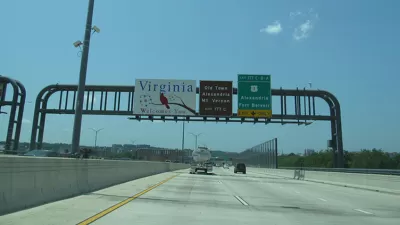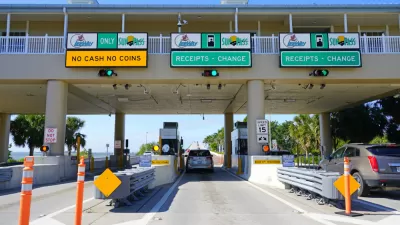But is it high enough? Everything is relative, and with the prior toll being only a buck per zone, the hope is that $2, which took effect Saturday, will cause some motorists to carpool to keep speeds at 55 mph during peak hours.
Express lanes, also called high-occupancy toll or HOT lanes when they allow carpools to access the toll lane at either no charge or at a discount, are popular with motorists who want a faster commute. But that popularity can cause oversubscription, as noted in a comprehensive post last April on the nation's growing express lane network.
Oversubscription: Low tolls = low speed due to congestion
"That’s part of the problem in the Salt Lake City area, where Utah officials hoped to keep traffic in the Interstate 15 toll lanes at 55 mph," writes Daniel C. Vock, Governing's transportation reporter. "Tolls there have been capped at $1 [per zone], and average speeds at peak times have dropped to 31 mph. State leaders are considering doubling -- or even tripling -- the maximum toll."
"The primary purpose of express lanes, originally designed to utilize excess capacity, is to encourage people to carpool," reports Lee Davidson for The Salt Lake Tribune on the July 14 toll increase. "Use of those lanes is free to vehicles with at least two passengers."
The minimum toll for each of the seven payment zones [pdf], each about 10 miles, is a quarter. With the toll increase, the maximum increased to $2 during peak traffic times.
"This dynamic pricing approach will allow the Utah Department of Transportation (UDOT) to better manage traffic in the Express Lanes to ensure that carpoolers continue to see the benefit of speeds around 55 mph," according to UDOT's webpage on Express Pass, the electronic payment system for the I-15 Express Lanes.
As always, carpoolers, buses, C Decal [clean fuel] vehicles and motorcycles are the first priority in the Express Lanes and may continue to use them without charge.
Quadrupling tolls considered
Apparently, policy-makers are skeptical that doubling the toll will do the decongestion trick, adds Davidson.
Sen. Howard Stephenson, R-Draper, chairman of the Revenue and Taxation Interim Committee, last year suggested “charging the maximum the market will bear” not only to reduce congestion but also to raise some money for highways.
Only one express lane in the U.S., to this correspondent's knowledge, applies that free-market approach. See "Capitalism at Work on an Interstate Highway," June 12, 2018.
Members of the Utah Transportation Commission also said a $2 maximum is not enough to reduce congestion and suggested making it $4 or more.
According to UDOT's press release on the toll increase, "During the 2018 Legislative session, lawmakers approved a maximum toll increase to as high as $4 to encourage more carpooling. UDOT opted to only increase the maximum to $2 per segment. The department will study the effectiveness of the increased fee before considering higher tolls in the future."
Jason Lee also reports on the toll doubling for Deseret News.
Additional information on the express lanes is available in the 219-page "I-15 Express Lanes Study: Phase II: Recommendations," [pdf] prepared for UDOT by Brigham Young University, Department of Civil and Environmental Engineering, published February 2015. From the executive summary:
There are three primary areas of recommendations for this research: 1) reduce violation rates along the corridor, 2) reduce volume in the ELs [express lanes] through an increase in tolls (and subsequent increase in speed), and 3) allow an increase in "C" decal vehicles once additional capacity is available.
Information on other approaches to reducing congestion in the express lane, such as restricting the toll-exemption for clean fuel vehicles, prohibiting solo-drivers to access express lanes when speeds drop, and dealing with the ongoing problem of cheating, was included in last October's post, also based on Lee Davidson's thorough reporting.
Hat tip AASHTO DTU.
FULL STORY: Drivers may pay twice as much to use I−15 express lanes starting Saturday as UDOT doubles maximum toll

Planetizen Federal Action Tracker
A weekly monitor of how Trump’s orders and actions are impacting planners and planning in America.

Chicago’s Ghost Rails
Just beneath the surface of the modern city lie the remnants of its expansive early 20th-century streetcar system.

San Antonio and Austin are Fusing Into one Massive Megaregion
The region spanning the two central Texas cities is growing fast, posing challenges for local infrastructure and water supplies.

Since Zion's Shuttles Went Electric “The Smog is Gone”
Visitors to Zion National Park can enjoy the canyon via the nation’s first fully electric park shuttle system.

Trump Distributing DOT Safety Funds at 1/10 Rate of Biden
Funds for Safe Streets and other transportation safety and equity programs are being held up by administrative reviews and conflicts with the Trump administration’s priorities.

German Cities Subsidize Taxis for Women Amid Wave of Violence
Free or low-cost taxi rides can help women navigate cities more safely, but critics say the programs don't address the root causes of violence against women.
Urban Design for Planners 1: Software Tools
This six-course series explores essential urban design concepts using open source software and equips planners with the tools they need to participate fully in the urban design process.
Planning for Universal Design
Learn the tools for implementing Universal Design in planning regulations.
planning NEXT
Appalachian Highlands Housing Partners
Mpact (founded as Rail~Volution)
City of Camden Redevelopment Agency
City of Astoria
City of Portland
City of Laramie




























